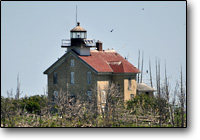 |
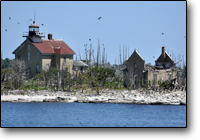 |
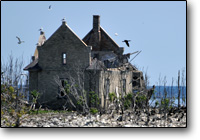 |
| Click thumbnails to view enlarged images | ||
| Pilot Island | Seeing The Light |
|
|
|
| Historical Information The
first light designed to guide ships negotiating the eastern entrance of
the Port Des Morts passage was constructed on Plum Island in 1846.
Complaining that this light was located too far west of the passage
entrance to be an effective aid to mariners, various influential
maritime interests lobbied the Lighthouse Board to relocate the light
to a more easterly location where it would better suit its intended
purpose. On May 28 1858, title to the 3.5-acre island then known as Port Du Morts (French for Door of the Dead), was transferred to the Lighthouse Board for the construction of a new light station, and work began on constructing the new station on Port Du Morts Island later that year. 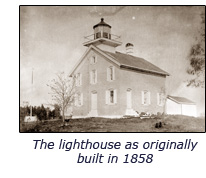 Consisting
of a two story cream city brick keepers dwelling, an integral square
tower was located at the apex of the roof at its' western end. Capped
with a decagonal cast iron lantern room and equipped with a revolving
Fourth Order Fresnel lens with six bulls-eyes which ran an arc of light
across th1858e horizon every minute. While the vent ball of the lantern
stood only thirty-four feet above the ground, the site's elevation
placed the light at a 38 foot focal plane and afforded a distance of
visibility of 12 miles in clear weather. Consisting
of a two story cream city brick keepers dwelling, an integral square
tower was located at the apex of the roof at its' western end. Capped
with a decagonal cast iron lantern room and equipped with a revolving
Fourth Order Fresnel lens with six bulls-eyes which ran an arc of light
across th1858e horizon every minute. While the vent ball of the lantern
stood only thirty-four feet above the ground, the site's elevation
placed the light at a 38 foot focal plane and afforded a distance of
visibility of 12 miles in clear weather.  As
a result of thick fogs which frequently blanketed the passage, a
Daboll’s trumpet powered by one of Ericsson’s caloric engines was
installed in a timber frame building on the island in 1864. However,
reports from the district Lampist on the equipment during his annual
tour of stations in the district indicated that it was very difficult
to keep the caloric engine operating effectively, and that the trumpet
was thus frequently in inoperable condition. With mariners lodging
numerous complaints about the signals lack of dependability, the
district engineer received approval and funding to replace the aging
Daboll system with a steam operated siren at the station in 1875. As
a result of thick fogs which frequently blanketed the passage, a
Daboll’s trumpet powered by one of Ericsson’s caloric engines was
installed in a timber frame building on the island in 1864. However,
reports from the district Lampist on the equipment during his annual
tour of stations in the district indicated that it was very difficult
to keep the caloric engine operating effectively, and that the trumpet
was thus frequently in inoperable condition. With mariners lodging
numerous complaints about the signals lack of dependability, the
district engineer received approval and funding to replace the aging
Daboll system with a steam operated siren at the station in 1875. 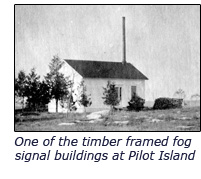 The
new siren proved to be a rousing success to maritime community, and
to further ensure that the signal was always ready for operation,
the lighthouse tender WARRINGTON delivered a work crew, duplicate steam
plant, siren and materials to erect a second timber framed signal
building at the station in 1880. While on the island the construction
crew also erected a wood shed, replaced some of the floor planking and
re-plastered walls in the dwelling and repainted all the station
outbuildings. The
new siren proved to be a rousing success to maritime community, and
to further ensure that the signal was always ready for operation,
the lighthouse tender WARRINGTON delivered a work crew, duplicate steam
plant, siren and materials to erect a second timber framed signal
building at the station in 1880. While on the island the construction
crew also erected a wood shed, replaced some of the floor planking and
re-plastered walls in the dwelling and repainted all the station
outbuildings. Audible
for a distance of forty miles in favorable conditions, the sirens at
Pilot Island were reputed to be the loudest on all the Lakes. A visitor
to the island in 1890 noted that all the kerosene lamps in the station
were suspended from the ceiling by strings, to prevent the vibrations
from extinguishing their flames. It was further reported, yet
unsubstantiated, that eggs laid by the keeper’s chickens never hatched,
since the vibrations of the foghorns "scrambled" their contents in the
shell. Audible
for a distance of forty miles in favorable conditions, the sirens at
Pilot Island were reputed to be the loudest on all the Lakes. A visitor
to the island in 1890 noted that all the kerosene lamps in the station
were suspended from the ceiling by strings, to prevent the vibrations
from extinguishing their flames. It was further reported, yet
unsubstantiated, that eggs laid by the keeper’s chickens never hatched,
since the vibrations of the foghorns "scrambled" their contents in the
shell.To better achieve consistency in equipment, the WARRINTON returned to Pilot Island to deliver a work crew to remove the sirens and their aging steam plants and replace them with standardized duplicate 10” steam whistles which were placed into service on May 18, 1894. The district Lampist was also on board with a new lens, and two weeks later on June 4, the characteristic of the lens was again changed from fixed red to fixed white with a white flash every 15 seconds. 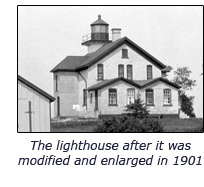 With
three keepers making their home in the dwelling, living quarters had
become decidedly cramped, and a crew arrived in 1901 to modify the
dwelling into a duplex for the Head Keeper and First Assistant, each
half of the renovated building incorporating its own entrance, stairway
and cellar. The crew also enlarged one of the fog signal buildings and
moved all the fog signal equipment into that one building. The
remaining empty fog signal building was then converted into quarters
for the Second Assistant Keeper. A new oil storage house, outhouse,
barn and workshop were also constructed, making Pilot Island the major
station in the Door County area. With
three keepers making their home in the dwelling, living quarters had
become decidedly cramped, and a crew arrived in 1901 to modify the
dwelling into a duplex for the Head Keeper and First Assistant, each
half of the renovated building incorporating its own entrance, stairway
and cellar. The crew also enlarged one of the fog signal buildings and
moved all the fog signal equipment into that one building. The
remaining empty fog signal building was then converted into quarters
for the Second Assistant Keeper. A new oil storage house, outhouse,
barn and workshop were also constructed, making Pilot Island the major
station in the Door County area.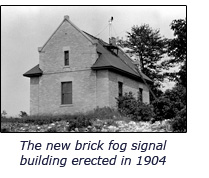 Never
content to leave a stone unturned, the Lighthouse Board decided to
again replace the fog signal equipment at Pilot Island In 1904, this
time installing a compressed air operated air siren system. Rather than
modifying the timber frame fog signal building that had been expended
four years previous, the decision was made to erect a completely new
brick fog signal building, and to this end the tender HYACINTH landed a
work party, machinery and materials on the island in the latter part of
June. Construction of the new brick fog signal building and the
installation of the duplicate 16-horsepower oil engines, compressors
and sirens were finished on September 12, and before leaving the island
with the old boilers, the work crew also extended the boatways and
docks on both sides of the island. Never
content to leave a stone unturned, the Lighthouse Board decided to
again replace the fog signal equipment at Pilot Island In 1904, this
time installing a compressed air operated air siren system. Rather than
modifying the timber frame fog signal building that had been expended
four years previous, the decision was made to erect a completely new
brick fog signal building, and to this end the tender HYACINTH landed a
work party, machinery and materials on the island in the latter part of
June. Construction of the new brick fog signal building and the
installation of the duplicate 16-horsepower oil engines, compressors
and sirens were finished on September 12, and before leaving the island
with the old boilers, the work crew also extended the boatways and
docks on both sides of the island.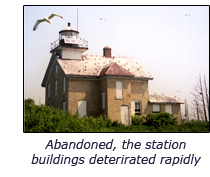 With
the universal adoption of radar and LORAN, the Coast Guard determined
that the fog signal was no longer essential to navigation, and it was
eliminated and the equipment removed from the fog signal building
during the station's automation in 1963. With
the universal adoption of radar and LORAN, the Coast Guard determined
that the fog signal was no longer essential to navigation, and it was
eliminated and the equipment removed from the fog signal building
during the station's automation in 1963.Without the constant attention of devoted Keepers, the grounds are now overgrown, and the dwelling and empty fog signal building are the only remaining structures. Seabirds have taken over the island, and almost everything is covered with a white crust of guano. A modern solar powered 300mm acrylic lantern still guides mariners from the tower.  In
October 2007, the Bureau of Land Management of the United States
Department of the Interior enlarged the Green Bay National Wildlife
Refuge to include Plum and Pilot Islands and jurisdiction of the
islands was transferred from the Coast Guard to the Fish and Wildlife
Service. The local grassroots "Friends of Plum and Pilot Islands" group
was formed, and in partnership with the USFWS is working to stabilize
the historic Lighthouse and Lifesaving buildings on both islands. In
October 2007, the Bureau of Land Management of the United States
Department of the Interior enlarged the Green Bay National Wildlife
Refuge to include Plum and Pilot Islands and jurisdiction of the
islands was transferred from the Coast Guard to the Fish and Wildlife
Service. The local grassroots "Friends of Plum and Pilot Islands" group
was formed, and in partnership with the USFWS is working to stabilize
the historic Lighthouse and Lifesaving buildings on both islands.For information, contact FOPPI at: 126 Country Club Drive, Clintonville, WI 54929 or www.plumandpilot.org Keepers of this Light Click Here to see a complete listing of all Pilot Island Light keepers compiled by Phyllis L. Tag of Great Lakes Lighthouse Research. Seeing this Light Pilot Island can be seen from the Washington Island Ferry, when making the trip from the Door peninsula to Washington Island. For a closer view, there are a number of charter boat services which offer closer trips around the island. One of the most convenient is operated by the Shoreline Charters at Gills Rock. At $39, their narrated lighthouse cruise includes close-up passes of Plum and Pilot Islands, along with views of Washington and Detroit Islands. Contach Shoreline Charters at 920-421-0922 Reference Sources Annual reports of the Lighthouse Board, various Annual reports of the Commissioner of Lighthouses, various Great Lakes Light list, various Journal of the 11th District Lampist, various The Cleveland Leader, Door County Advocate, various Keeper listings for this light appear courtesy of Great Lakes Lighthouse Research |